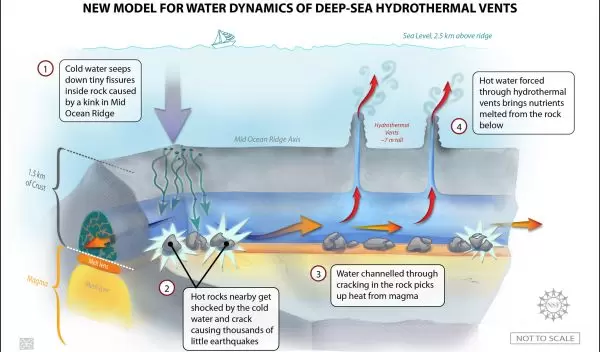
Quakes Under Pacific Ocean Floor Reveal Unexpected Circulation System
Zigzagging some 60,000 kilometers across the ocean floor, Earth's system of mid-ocean ridges plays a pivotal role in many workings of the planet: plate-tectonic movements, heat flow from the interior, and the chemistry of rock, water and air.
Now, a team of seismologists working in 2,500 meters of water on the East Pacific Rise, some 565 miles southwest of Acapulco, Mexico, has made the first images of one of these systems--and it doesn't look the way most scientists had assumed. The results of the National Science Foundation (NSF)-supported research appear in this week's issue of the journal Nature.
It was not until the late 1970s that scientists discovered the existence of vast plumbing systems under the oceans called hydrothermal vents. The systems pull in cold water, superheat it, then spit it back out from seafloor vents--a process that brings up not only hot water, but dissolved substances from rocks below. Unique life-forms feed off the vents' stew, and valuable minerals, including gold, may pile up.
The hypothetical image of a hydrothermal-vent system shows water forced down by overlying pressure through large faults along ridge flanks. The water is heated by shallow volcanism, then rises toward the ridges' middles, where vents (often called "black smokers" for the cloud of chemicals they exude) tend to cluster.
"The new images show a very different arrangement," said Rodey Batiza, marine geosciences section head in NSF's Division of Ocean Sciences.
The research team's calculations suggest that water moves a lot faster than previously thought--perhaps a billion gallons per year--through these systems. The water appears to descend instead through a buried 200-meter-wide chimney atop the ridge studied on the East Pacific Rise, run below the ridge along its axis through a tunnel just above a magma chamber, then bubble back up through a series of vents further along the ridge.
"If you look at images of hydrothermal vents, you come up with cartoons that don't at all match what we see," said lead Nature paper author Maya Tolstoy, a marine geologist at Lamont-Doherty Earth Observatory in Palisades, N.Y.
The images were created using seismometers planted around the ridge to record tiny, shallow earthquakes--in this study, 7,000 of them over seven months in 2003 and 2004.
The shallow quakes cluster neatly, outlining the cold water's apparent entrance. It dives straight down about 700 meters, then fans out into a horizontal band about 200 meters wide, before bottoming out at about 1.5 kilometers just above the magma. Heated water rises back up through a dozen vents about 2 kilometers north along the ridge.
The researchers interpret the quakes as being the result of cold water passing through hot rocks and picking up their heat--a process that shrinks the rocks and cracks them, creating small quakes.
Seawater, forced down into the resulting space, eventually gets heated by the magma, then rises back to the seafloor--much the same process seen in a pot of boiling water. Tolstoy and co-authors believe the water travels not through large faults--the model previously favored by some scientists--but through systems of tiny cracks.
Their chart of the water's route is reinforced by biologists' observations from submersible dives that the area around the downflow chimney is more or less lifeless, while the surging vents are covered with bacterial mats, mussels, tubeworms and other creatures that thrive off the heat and chemicals.
It is a mystery where vent organisms originally came from--some evolutionary biologists believe that life on Earth began with them--and how they make their way from one isolated vent system to another.
These findings could add to an understanding of seafloor currents along which they may move, and of the nutrient flows that feed them, said Tolstoy. The work also has large-scale implications for how heat and chemicals are cycled to the seafloor and overlying waters, she said.
Scientists are still retrieving and analyzing data on the vents and their circulation. In 2006, an ocean-bottom volcanic eruption buried many of their instruments; most of the instruments were lost, but the "survivors" provided new information about how undersea eruptions work.
